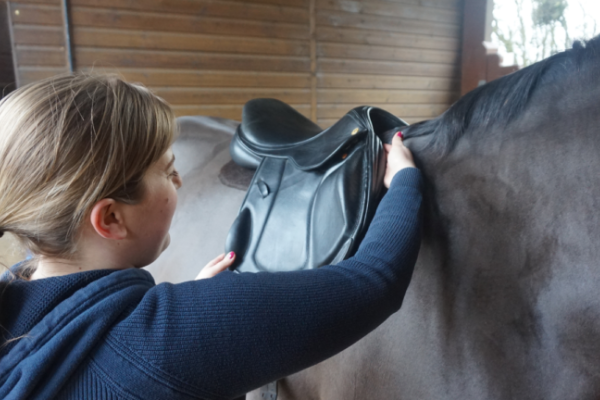3 reasons to have your saddle reflocked regularly
3 Reasons to Have Your Saddle Reflocked Regularly
A well-maintained saddle is crucial for the comfort and performance of both horse and rider. One key aspect of saddle maintenance is regular reflocking. Reflocking involves adding or adjusting the wool or synthetic fibers inside the saddle panels to ensure an even and supportive fit. Here are three compelling reasons why having your saddle reflocked regularly is essential.
1. Ensure Optimal Comfort and Fit for Your Horse
The primary reason for reflocking your saddle is to maintain optimal comfort and fit for your horse. Over time, the flocking in a saddle can become compacted and uneven, leading to several issues:
- Pressure Points: Compacted or uneven flocking can create pressure points that cause discomfort and pain for the horse. This discomfort can manifest as resistance, behavioural changes, or even physical soreness and injury.
- Back Pain and Soreness: Poor saddle fit due to inadequate flocking can lead to chronic back pain and soreness. This can significantly affect the horse's performance and overall well-being.
- Performance Issues: A horse that is uncomfortable due to an ill-fitting saddle may exhibit performance issues, such as reluctance to move forward, stiffness, or difficulty maintaining a consistent gait.
Regular reflocking helps to distribute the rider’s weight evenly across the horse’s back, reducing the risk of pressure points and ensuring a comfortable fit. This not only enhances the horse’s comfort but also promotes better performance and a more enjoyable riding experience.
2. Prolong the Life of Your Saddle
Investing in regular reflocking can significantly extend the lifespan of your saddle. Saddles are a considerable investment, and proper maintenance is essential to protect that investment. Here’s how reflocking contributes to saddle longevity:
- Maintains Saddle Structure: Over time, the structural integrity of a saddle can be compromised if the flocking becomes uneven or compacted. Regular reflocking helps maintain the saddle's shape and structure, preventing premature wear and tear.
- Prevents Leather Damage: Uneven flocking can cause undue stress on certain areas of the saddle’s leather, leading to cracks, stretching, or other damage. By keeping the flocking in good condition, you ensure that the leather remains evenly supported and less prone to damage.
- Reduces Need for Major Repairs: Addressing flocking issues early through regular maintenance can prevent more significant problems that require expensive repairs. This proactive approach saves money in the long run and keeps your saddle in top condition.
Regular reflocking not only enhances the functionality and comfort of your saddle but also helps preserve its aesthetic appeal and resale value.
3. Adapt to Changes in Your Horse’s Shape
Horses’ bodies change over time due to various factors such as age, fitness level, and seasonal changes in weight. A saddle that fits perfectly today may not fit as well in a few months. Regular reflocking allows you to adapt your saddle to these changes:
- Accommodate Muscle Development: As your horse’s training progresses, muscle development can alter the shape of its back. Regular reflocking ensures that the saddle continues to fit well as these changes occur.
- Seasonal Weight Fluctuations: Horses often experience weight fluctuations throughout the year, especially between winter and summer. Adjusting the flocking seasonally helps maintain a proper fit regardless of these changes.
- Age-Related Changes: Older horses may lose muscle mass or develop different conformational issues. Regular reflocking can adapt the saddle to accommodate these age-related changes, ensuring continued comfort.
By having your saddle reflocked regularly, you can ensure that it remains a good fit for your horse throughout these natural changes, promoting long-term comfort and performance.
How Often Should Your Saddle Be Reflocked?
The frequency of reflocking depends on several factors, including the type of flocking material, the amount of use the saddle gets, and changes in your horse's condition. However, a general guideline is to have your saddle checked every six months and reflocked and checked every 2 years internally. If your horse undergoes significant changes in weight, musculature, or condition, more frequent adjustments may be necessary.
How to Tell If Your Saddle Needs Reflocking
There are several signs that indicate your saddle may need reflocking:
- Visible Signs of Wear: Uneven or compacted panels, visible lumps, or areas where the flocking feels hard or thin.
- Behavioral Changes in Your Horse: Increased resistance, reluctance to move forward, or signs of discomfort during tacking up or riding.
- Physical Symptoms: Soreness or sensitivity in the horse's back, uneven sweat patterns, or hair loss in areas where the saddle makes contact.
If you notice any of these signs, it’s important to consult with a professional saddle fitter.
Not sure who your local fitter is? Click here to find out.
Recognising Saddle Fit Issues Course
The "Recognising Saddle Fit Issues" course offered here at The Saddle Bank is a valuable resource for horse owners. This course teaches you how to identify saddle fit problems early, ensuring that you can address them before they lead to significant discomfort or injury for your horse. By understanding the signs of poor saddle fit, you can make informed decisions about when to have your saddle reflocked or adjusted.
Click here to get started now!
Conclusion
Regular reflocking is essential for maintaining the comfort and performance of both your horse and your saddle. By ensuring optimal fit, prolonging the life of your saddle, and adapting to changes in your horse’s shape, regular reflocking helps prevent discomfort and enhance your riding experience. Keep an eye out for signs that your saddle needs reflocking and consider professional courses to enhance your knowledge and care for your equine partner.


















